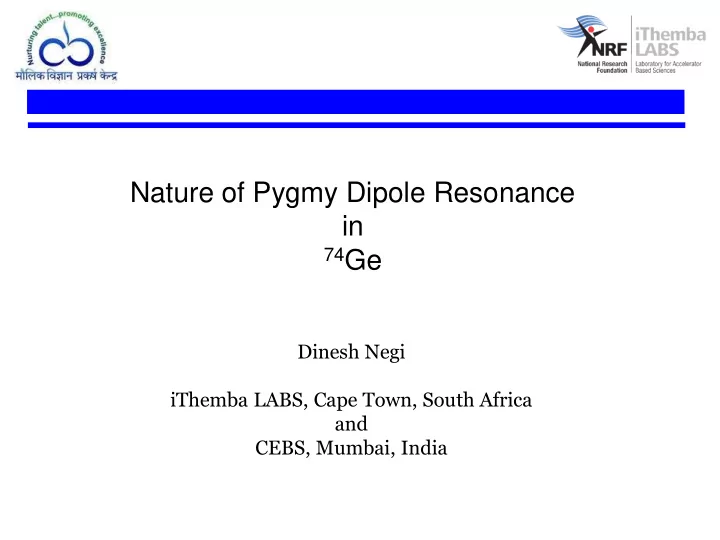

Nature of Pygmy Dipole Resonance in 74 Ge Dinesh Negi iThemba LABS, Cape Town, South Africa and CEBS, Mumbai, India
The Pygmy Dipole Resonance Oscillation of neutron skin against the core Pygmy Dipole Giant Dipole Resonance Resonance PDR : Open questions How PDR effects r-process nucleosynthesis ? How collective it is ? Is ‘ isospin- splitting’ a general phenomenon ? Hoe does PDR depends on N/Z ?
The Pygmy Dipole Resonance Oscillation of neutron skin against the core Pygmy Dipole Giant Dipole Resonance Resonance PDR : Open questions How PDR effects r-process nucleosynthesis ? How collective it is ? Is ‘ isospin- splitting’ a general phenomenon ? Hoe does PDR depends on N/Z ? Use of complementary probes to reveal details of structure . Photon scattering : - dominant isovector excitation (for E1) - interaction with whole nucleus (kR << 1) scattering : - dominant isoscalar excitation (hadronic interaction) - interaction dominant at the surface
Recent studies on E1 Strength distribution using ( , ’ ) reaction
Recent studies on E1 Strength distribution using (H-Ion,H- Ion’ ) reaction 208 Pb( 17 O, 17 O’) 208 Pb F.Crespi et al ., PRL 113, 012501 (2014) F.Crespi et al ., PRC 91, 024323 (2015)
Scenario so far regarding studies with heavy ion scattering reactions Studies are limited to 130 mass region (except few cases) are done on nuclei with relatively larger N/Z asymmetry. Isospin -splitting is found in most of nuclei. Need for investigation in other mass regions (also in nuclei with lower N/Z asymmerty) Experimental effort was made to study low lying dipole states in 74Ge at iThemba LABS. N/Z = 1.32 Weakly deformed prolate in its ground state
Experiment in new region Population of excited states via inelastic scattering of 74 Ge using the following reaction 74 Ge( 4 He, 4 He’) 74 Ge @ 48 MeV For the detection of charged particles Telescope counters (Double sided) Silicon Strip Detectors Two Counters Thickness ( E) = 284 m Thickness (E) = 980 m At 45 degrees with respect to the beam axis For the detection of -rays HPGe detectors in Clover arrangement Nine Clover detectors. (AFRODITE Array at iThemba LABS)
Experimental technique for the study of Pygmy dipole resonance • Excitation energy of the system from the inelastically scattered alpha particles. • Simultaneous detection of decaying to the ground state . E x E E E x 0+ coincidence matrix Excellent selection of J =1 - states (for E x > 5 MeV in even-even nucleus)
RESULTS charged particle E E - - timing relationship Raw Particle Identification plot Red data are random events particle spectrum Blue data are after random subtraction ( with in coincidence) Energy resolution ~ 250 keV
RESULTS cont…. | E – E | < 130 keV Pygmy dipole states E = E x “ ” represent known states from earlier works “ ” indicate position of an absent transition observed in ( , ’) data
Comparison with ( , ’ )data Experimental Results Observations : Relatively larger isoscalar contribution for states E < 5 MeV. Relatively larger isovector contribution for states E > 5 MeV . ( , ’) data taken from A. Jung et al., Nucl. Phys. A 584 (1995) 103.
Comparison with ( , ’ )data Experimental Results Theoretical Calculations Theoretical calculations: RQTBA calculation. Qualitatively reproduces the trend of decreasing isoscalar strength with increasing excitation energy. ( , ’) data taken from A. Jung et al., Nucl. Phys. A 584 (1995) 103.
Comparison with ( , ’ )data Experimental Results Theoretical Calculations Theoretical calculations: RQTBA calculation. Qualitatively reproduces the trend of decreasing isoscalar strength with increasing excitation energy. Transition densities exhibit compressional mode at low energies and isospin mixed mode at higher energies.
Comparison to earlier work with ( , ’ ) reaction J. Enders et al., PRL 105, 212503 Observations: Stronger isoscalar response at low energies ( E < 5 MeV) compared to earlier works. No isospin splitting in the pygmy region, i.e. 6 – 8 MeV. ( , ’) data taken from A. Jung et al., Nucl. Phys. A 584 (1995) 103. Isocalar response is same for dipole states in this energy region.
Contribution of Coulomb interaction For dipole states at E = 7.01 MeV For dipole states at E = 4.55 MeV DWBA Calculations (DWUCK4 code) Using microscopic transitions densities from RQTBA calculations. Negligible contribution from Coulomb interaction
Conclusions : Isospin splitting of PDR is not observed in 74 Ge Relatively large isoscalar components of dipole states at lower energies (E < 5 meV) and interact differently with nucleus. (surface vs whole nucleus) Importance of complementary probe, alpha, in deducing information.
Collaboration M. Weideking, R.A. Bark, T.S. Dinoko, E.G. Lanza and A. Vitturi J.L.Easton, P. Jones, B.V. Kheswa, E.A. Lawrie, INFN, Sezione de Catania, Italy J.J. Lawrie, S.N.T. Majola, M.R. Nchodu, J, INFN Sezione de Padova, Italy Ndayishimye, S.P. Noncolela, O. Shirinda, T.D. Singo-Bucher iThemba LABS, Somerset West, South Africa E. Litvinova Western Michigan University, Kalamazoo, USA P. Papka, R. Newman University of Stellenbosch, L. A. Bernstein, D. L. Bleuel, and B. Daub Stellenbosch, South Africa Lawrence Livermore National Laboratory, Livermore, USA J. N. Orce, N. Erasmus University of the Western Cape, A. Görgen, M. Guttormsen, A. C. Larsen, Bellville, South Africa S. Siem,T. Renstrom, University of Oslo, Oslo, Norway D.G. Roux S. Bvumbi and L.P. Masiteng, University of Johannesburg, Rhodes University, Grahamstown, Johannesburg, South Africa. South Africa Thank You
RESULTS cont…. Particle Spectrum with banana gate -ray Spectrum 74 Ge 73 Ge
Recommend
More recommend